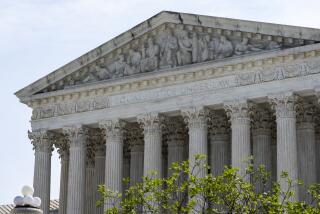Ruling Against Integration Plans Could Add to L.A. Schools’ Burden
- Share via
Like many urban school systems around the country, the Los Angeles Unified School District will be watching this fall when the U.S. Supreme Court considers the constitutionality of desegregation programs in Seattle and Louisville, Ky.
Already under legal assault for considering race in assigning students to its magnet school system, Los Angeles Unified might face a new challenge if the high court uses the two desegregation cases to broadly strike down affirmative action in public elementary and secondary schools.
But legal experts disagree about how vulnerable the district could be, in part because it’s difficult to predict the scope of any court ruling.
“What the court decides very well could have application for Los Angeles, depending on how the court decides to write the decision,” said Erwin Chemerinsky, a professor of constitutional law at Duke University Law School.
The impact, he said, could range from “broad authorization” of race-based programs to a “complete prohibition” -- and anything in between.
Los Angeles adopted its magnet school program under court order in 1977 as a voluntary system of integration, replacing an unpopular foray into forced busing. At the time, almost 40% of the district’s students were white, about one-third Latino and one-quarter black.
The system established schools with specialized or enhanced curricula, under the assumption that they would draw students together from racially isolated parts of the city. To further encourage integration, the system also established a formula with race as one factor.
In today’s district, fewer than one in 10 students is white, and the system reserves 30% to 40% of magnet seats for white children.
The district now faces a lawsuit by the American Civil Rights Foundation. The foundation charges that weighing race in admissions to magnet schools violates California law.
Mark Rosenbaum, legal director of the American Civil Liberties Union of Southern California, helped formulate the magnet system and remains its defender. He insisted that the Supreme Court reviews of the Seattle and Louisville cases “will have no effect on Los Angeles.”
That is because the magnet programs in L.A. are under a state court order, he said, and comply with the state Constitution. The state Constitution is more expansive than the federal Constitution in the protections it provides discrimination victims.
On the other side of the political and legal spectrum, Sharon Browne, a lawyer for the Pacific Legal Foundation, which brought the lawsuit against Los Angeles Unified, agreed that a Supreme Court ruling “won’t affect Los Angeles at all.”
Much like Rosenbaum, Browne argued that the state Constitution grants greater protection from discrimination than the U.S. Constitution. However, she defines that protection as offering relief from mandated integration. Browne has based her argument -- and her lawsuit -- on Proposition 209, a constitutional amendment passed by California voters in 1996. It bans preferential treatment based on race in public programs.
Douglas Kmiec, a constitutional scholar at Pepperdine University Law School, said any ruling by the Supreme Court based on the U.S. Constitution would likely trump the state Constitution.
“The federal Constitution is the floor ... of constitutional guarantees,” he said, “While state constitutions can expand those constitutional guarantees, they can’t do it at the cost of other people’s constitutional rights.”
Kmiec said he thought it likely that the court would issue a ruling that would affect the Los Angeles schools, although he said it could depend on how similar the Los Angeles system is to the two districts being reviewed.
The Kentucky district has a desegregation plan in which race plays some role in admissions to all schools, not just magnets. The Seattle high schools require students to apply to the schools of their choice, and then use race as a “tiebreaker” in the most popular schools.
More to Read
Sign up for Essential California
The most important California stories and recommendations in your inbox every morning.
You may occasionally receive promotional content from the Los Angeles Times.













